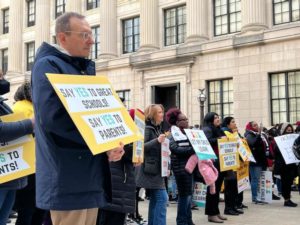Ouch. That’s Dr. Bruce Baker’s assessment
of our analysis
of Gov. Christie’s seizure of school district surplus to garner $475 million to help plug up this year’s budget deficit. Dr. Baker bases his slap-down on the (true) fact that we haven’t taken into account district size: “larger districts take in larger surpluses,” so our conclusions are unfair because Abbott/poor districts are taking the biggest hit even though “Abbott districts seem to be carrying somewhat smaller per pupil surpluses.”
A couple of points. First of all, surplus is generally used to buy down tax increases. Typically a district will take a chunk out of surplus at budget time and apply it to the bottom line, just like someone buys down points on home mortgages to lower the interest. Abbott districts don’t need to buy down tax increases because school costs are almost completely covered by State aid. Example: Union City has a total operating budget for the 2009-2010 school year of $193,988,694. However, the total tax levy – the amount of taxes collected from local residents – is only $15,418,637. That’s less than 8%, and rightfully so, because the poverty level in Union City is so high. The point is that this district doesn’t need the surplus to drive down local property taxes. Let’s take another example: Hamilton School District in Mercer County, with a DFG of FG. Hamilton’s total operating budget is $178,812,981 and the amount of tax levy collected from residents is $92,579,869. That’s more than 50%. One can certainly make the argument that Hamilton needs more money in surplus to buy down the tax rate. Yet Union City has a surplus of over $29,000,000 and Hamilton has a surplus of about $3,500,000. (Here’s the link to our surplus spreadsheet.)
Dr. Baker also avers that larger districts, generally poor urban ones, need bigger surpluses because they have more kids, i.e., on a per pupil basis their surpluses are smaller. Union City’s total public school population is 9,730 students and Hamilton’s is 13,015.
Our more important point in the original post was not that Abbott districts get too much state aid. The point was that the children within these districts present with enormous educational, social, and developmental needs. State aid should not be shoved into surplus lines but spent on the kids. There’s something screwy with a system that allots equalization aid intended to compensate for poverty, yet districts relegate substantial portions of that aid into a surplus account.
Here’s a question for Dr. Baker: how does per pupil surplus vary by district size? Is there a difference between Abbotts and non-Abbotts of comparable size?



2 Comments